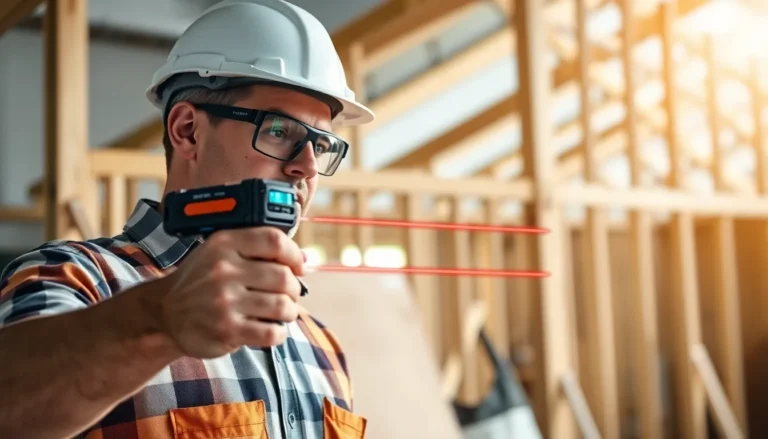Table of Contents
ToggleImagine a world where your coffee brews itself as you wake up and your thermostat knows just how to keep you cozy without breaking the bank. Welcome to the realm of IoT and smart home tech, where everyday devices become your personal assistants. It’s like living in a sci-fi movie, minus the flying cars and awkward robot companions.
The Internet of Things (IoT) connects everything from your fridge to your light bulbs, making life not just easier but a bit more fun. Smart home technology isn’t just a trend; it’s a revolution that transforms mundane tasks into seamless experiences. Get ready to discover how these innovations can turn a regular house into a high-tech haven, giving you more time for what really matters—like binge-watching your favorite shows without a care in the world.
What Is IoT and Smart Home Tech?
IoT refers to the interconnected network of devices that communicate with each other via the internet. It encompasses a variety of everyday items, such as appliances, security systems, and wearable technology, that can send and receive data. Smart home technology takes this concept further by integrating IoT into residential settings, allowing homeowners to control devices remotely.
Smart thermostats, for example, adjust heating and cooling based on user preferences and patterns. They provide energy savings while enhancing comfort. Smart lights enable users to control brightness and color from a smartphone or through voice commands. Homeowners can create schedules or set scenes for different times of the day.
Security cameras equipped with IoT capabilities offer real-time monitoring and alerts. Integration with smartphones allows users to view feeds and receive notifications when unusual activity occurs. Smart locks add an additional layer of security, granting access through smartphones instead of traditional keys.
Major brands have entered the smart home market, providing consumers with choices ranging from budget-friendly options to high-end systems. Compatibility between devices often improves user experience. Some systems even incorporate artificial intelligence to learn habits, further streamlining daily tasks.
The result of these advancements is a seamless home environment that responds to individual needs. By leveraging smart technology, users can enhance efficiency and convenience. The shift toward smart homes signifies a broader trend in digital living, marking a significant transition in how households operate and interact with technology.
Key Components of IoT
The IoT ecosystem comprises several essential components that work together to create smart, automated environments. Understanding these elements enhances the appreciation of smart home technology.
Sensors and Actuators
Sensors detect changes in the environment and collect data for analysis. Common examples include temperature sensors, motion detectors, and humidity sensors. Actuators, on the other hand, respond to commands by performing physical actions. Smart locks and thermostats serve as prime examples of actuators. Together, sensors and actuators form the backbone of a smart home, enabling real-time feedback and automation. This integration simplifies everyday tasks, such as adjusting lighting or controlling appliances, ultimately contributing to energy efficiency and increased comfort.
Connectivity Technologies
Connectivity technologies allow devices to communicate with each other over the internet. Wi-Fi, Bluetooth, and Zigbee are popular options that facilitate this interaction. Wi-Fi provides high data transfer rates over a wider range, making it suitable for bandwidth-heavy devices. Bluetooth connects devices over shorter distances, ideal for wearables such as smartwatches. Zigbee, a low-power wireless standard, supports numerous IoT devices and is efficient for battery-operated sensors. Each technology serves a distinct purpose, ensuring seamless integration and operation among various smart home gadgets.
Benefits of Smart Home Technology
Smart home technology offers numerous advantages that enhance daily living. Its features significantly improve convenience, security, and energy management.
Enhanced Security
Enhanced security systems protect homes through smart surveillance technologies. Smart cameras provide real-time monitoring, allowing homeowners to view live feeds from smartphones. Sensors detect motion and send alerts instantly, ensuring quick responses to potential threats. Smart locks offer remote access control, enabling users to grant entry to guests even when away. The ability to monitor home security from anywhere provides peace of mind for families and individuals alike. Furthermore, automation can simulate human presence, adding an additional layer of deterrence against break-ins.
Energy Efficiency
Energy-efficient smart home devices save money and reduce environmental impact. Smart thermostats learn user preferences, optimizing heating and cooling schedules automatically. Adjustments made through mobile apps help minimize energy consumption when homeowners are away. Smart lighting systems enable precise control, allowing users to set schedules and dim lights based on need. These systems contribute significantly to overall energy savings. Additionally, appliances like smart plugs monitor energy usage in real time, informing users how to further reduce waste. Overall, these innovations help create a more sustainable living environment.
Challenges in IoT and Smart Homes
Challenges emerge as the adoption of IoT and smart home technologies grows. Addressing these obstacles is essential for maximizing their benefits.
Privacy Concerns
Privacy concerns pose significant challenges in IoT and smart homes. Devices regularly collect personal data, including user behavior and habits. Many homeowners worry about unauthorized access to sensitive information. Security breaches can lead to identity theft or data leaks, underscoring the need for robust security measures. Transparency in data usage and storage is crucial for building user trust. By prioritizing privacy protections, companies can create safer smart home environments.
Interoperability Issues
Interoperability issues affect the seamless operation of smart devices. Different manufacturers often use proprietary platforms, leading to compatibility challenges among devices. Users may find it difficult to integrate gadgets from various brands into a cohesive ecosystem. These limitations can frustrate homeowners seeking convenience and control over their environments. Ongoing industry efforts aim to establish common standards to enhance compatibility. By focusing on interoperability, manufacturers can facilitate a more unified smart home experience.
Future Trends in IoT and Smart Homes
Emerging trends in IoT and smart home technology point to continued innovation. Significant advancements in artificial intelligence and machine learning will shape smart home ecosystems.
AI and Machine Learning Integration
AI and machine learning enhance user experiences in smart homes. These technologies analyze behavior patterns, allowing devices to adapt automatically. For instance, smart thermostats learn preferred temperature settings over time, optimizing energy use accordingly. Home assistants respond more effectively through voice recognition improvements, adapting to users’ unique commands and preferences. Improved algorithms streamline information processing, yielding proactive responses to various household needs. Continued integration of AI fosters a more intuitive and personalized living experience, catering to comfort and convenience.
Increased Automation
Automation remains a dominant trend in smart homes, revolutionizing daily routines. Device interconnectivity enables seamless scheduling and task execution across multiple platforms. For example, automated lighting adjusts based on occupancy, enhancing energy efficiency. Home security systems implement advanced automation, triggering alerts and locking doors autonomously when detecting unusual activity. This integration extends to appliances, where refrigerators monitor food inventory and suggest recipes. Increased automation allows users to enjoy a more hands-free lifestyle, significantly simplifying daily tasks and responsibilities.
The evolution of IoT and smart home technology is reshaping the way people live and interact with their environments. As devices become more interconnected and intelligent, they offer unparalleled convenience and efficiency. Homeowners can enjoy enhanced security and energy management while simplifying daily tasks.
While challenges like privacy concerns and interoperability remain, ongoing advancements in technology promise to address these issues. The future of smart homes looks bright with the integration of AI and increased automation, paving the way for even more intuitive living experiences. Embracing these innovations not only enhances comfort but also contributes to a sustainable lifestyle.







